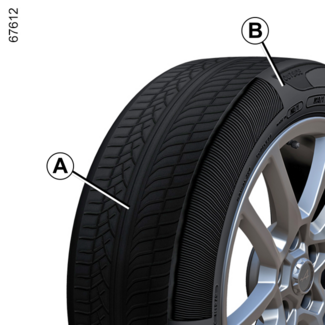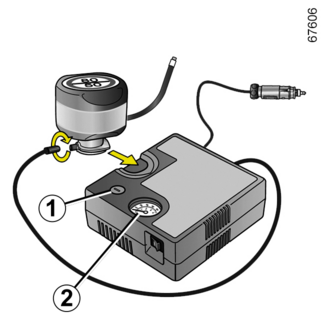Back to the list


Tyre inflation kit
Tyre inflation kit

WARNING
The kit repairs tyres when the tread A has been damaged by objects smaller than 4 mm. It cannot repair all types of puncture,
such as cuts larger than 4 mm, cuts in the tyre sidewall B, etc.
Ensure also that the wheel rim is in good condition.
Do not pull out the foreign body causing the puncture if it is still in the tyre.
WARNING
Do not attempt to use the inflation kit if the tyre has been damaged as a result of
driving with a puncture.
You should therefore carefully check the condition of the tyre sidewalls before any
operation.
Driving with underinflated, flat or punctured tyres can be dangerous and may make
the tyre impossible to repair.
This repair is temporary.
A tyre which has been punctured should always be inspected (and repaired, where possible)
by a specialist as soon as possible.
When taking a tyre which has been repaired using this kit to be replaced, you must
inform the specialist.
When driving, vibration may be felt due to the presence of the repair product injected
into the tyre.
WARNING
The kit is only approved for inflating the tyres of the vehicle originally equipped
with the kit.
It must never be used to inflate the tyres of another vehicle, or any other inflatable
object (rubber ring, rubber boat, etc.).
Avoid spillage on skin when handling the repair product bottle. If droplets do leak
out, rinse them off with plenty of water.
Keep the repair kit away from children.
Do not dispose of the empty bottle in the countryside. Return it to your approved
dealer or to a recycling organisation.
The bottle has a limited service life which is indicated on its label. Check the expiry
date.
Contact an approved dealer to replace the inflation tube and repair product bottle.

WARNING
Before using the kit, park the vehicle at a sufficient distance from traffic, switch
on the hazard warning lights, apply the parking brake, ask all passengers to leave
the vehicle and keep them away from traffic.
In the event of a puncture, use the kit located in the luggage compartment.
Vehicle fitted with a tyre pressure monitoring system
If the tyres are under-inflated (puncture, low pressure, etc.), the  warning light appears on the instrument panel: refer to the information on "Tyre
pressure monitoring system" in Section 2.
warning light appears on the instrument panel: refer to the information on "Tyre
pressure monitoring system" in Section 2.
With the engine running and the parking brake applied,
- disconnect any accessories from the vehicle's accessories sockets;
- see the information on the inflation kit compressor located in the vehicle luggage compartment and follow the instructions for use;
- inflate the tyre to the recommended pressure (please refer to the information on "Tyre pressure");
- after a maximum of 15 minutes, stop inflating and read the pressure (on the pressure gauge 1).
Note: while the container is emptying (approximately 30 seconds), the pressure gauge
1 will briefly indicate a pressure of up to 6 bar, then the pressure drops;
- adjust the pressure: to increase it, continue inflation with the kit. To reduce it, press the button 2.
WARNING
If the vehicle is parked on the hard shoulder, you must warn other road users of your
vehicle's presence with a warning triangle or with other devices as per the legislation
applying to the country you are in.

If the recommended pressure of 1.8 bar cannot be achieved after 15 minutes, repair
is impossible. Do not drive the vehicle. Consult an approved dealer.
WARNING
Nothing should be placed around the driver’s feet as during sudden braking such objects
may slide under the pedals and obstruct their use.
Once the tyre is correctly inflated, remove the kit: unscrew the inflation adapter
slowly from the container 3 to prevent any product spatter and store the container in plastic packaging to prevent
product leaks.
- Affix the driving recommendation label (located under the container) to the dashboard where the driver can see it.
- Put the kit away.
- At the end of this initial inflation operation, air will still escape from the tyre. You must drive a short distance in order to seal the hole.
- Start the vehicle immediately and drive at a speed of 12 to 37 mph (20 to 60 km/h) in order to distribute the product evenly in the tyre. After driving a distance of 2 miles (3 km), stop the vehicle and check the tyre pressure.
- If the pressure is greater than 1.3 bar but less than the recommended pressure (refer to the label affixed to the edge of the driver's door or, depending on the vehicle, on the base of driver's door) and readjust it. Otherwise, contact an approved dealer: the tyre cannot be repaired.
Precautions when using the kit
The kit should not be operated for more than 15 consecutive minutes.
The container must be replaced after the first use even if liquid remains inside.
WARNING
Following repair with the kit, do not travel further than 124 miles (200 km). In addition,
reduce your speed and under no circumstances exceed 50 mph (80 km/h). The sticker,
which you must affix in a prominent position on the dashboard, reminds you of this.
Depending on the country or local legislation, a tyre repaired with the inflation
kit will need to be replaced.
WARNING
Please be aware that a poorly tightened or missing valve cap can make the tyres less
airtight and may lead to pressure loss.
Always use valve caps identical to the originals and screw them down fully.